Minelab E-Trac Field-Test Report, page 4
Conducting the Field-Test at Former Tavern Site Previously "Pounded" by Minelab Explorer II, White's XLT and Tesoro Cortes
I took the detector for testing to the site which my treasure hunting buddies and I "hammered" the day before (you can read my full story that includes some additional tips on mastering the E-Trac in Detecting at Swedish Tavern Site). The site was situated at the end of the abandoned grass field. The grass was cut by the local peasants in one half of the field, but the exact location of a Swedish road-pub ("krog" in Swedish language) was not mowed.
The krog was a single-standing small house, that stood there from 1620 to 1750, possibly until the mid 19th century. The site itself was of a small size - just 350 square yards.
The Site of Swedish Krog
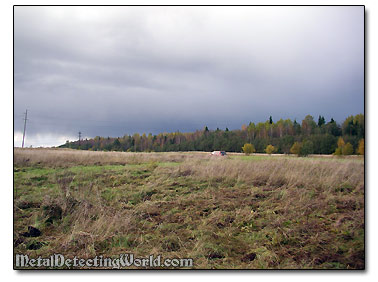
On a previous day, my buddies and I visited this location for the first time and searched only a half of its area - wherever we could get the search coils close to the ground surface through the grass or where the grass was flattened. We believed that we "pounded" the accessible spots of this site "to the last signal." Three metal detectors, Minelab Explorer II, White's DFX and Tesoro Cortes, were used on that day. I used Minelab Explorer II.
On this second trip, for the sake of testing my new E-Trac metal detector, I went on metal detecting the same spots. It was a windy October day with little rain. Because it was raining hard the day before, the soil had been saturated with water, and, of course, the tall grass was wet. I was using my E-Trac with headphones and the standard Double-D search coil.
All the coins that we found on a previous day were not buried deep because the soil was mixed with numerous flat pieces of limestone, a layer of them lying 7" deep underneath. The coins could not sink any deeper in the soil over the time period of a few centuries. In this case, the E-Trac's capability of detecting the targets buried at great depths was not tested.
Rather, the E-Trac's capability in recognizing the targets positioned at different angles in the soil or in close proximity to rusted iron nails was to be confirmed. And there were zillions of iron square nails in the ground in addition to the iron junk, old and modern! This metal detecting site was ideal for testing the Minelab E-Trac - currently the best and the most advanced machine on the market!
First of all, I performed the Noise Cancel procedure and noticed that the Auto Sensitivity level was just a little above the level of 'Suggested' Sensitivity which directly relates to the current ground conditions. Unlike the Explorer's actual Semi-Auto Sensitivity that is continuously adjusted as close as possible to the specified level, the E-Trac's Auto Sensitivity, depicted by the left bar with the numeric value, indicates the highest sensitivity level that one of the three internal signal channels is operating in. The 'Suggested Sensitivity (the right gray bar) indicates an average Sensitivity level of all three channels and should be used as a guide in setting the Manual Sensitivity if needed.
When I switched to Manual Sensitivity for the sake of experiment and set its level up higher than the level of Auto Sensitivity was, this caused the appearance of some false signals and unstable Target IDs. Right away, I found out that E-Trac is truly a very sensitive detector. I decided not to bother with Manual Sensitivity at this moment and switched back to Auto Sensitivity since the detector was functioning fine with this program setting. When I visit this site next time, I will experiment with Manual Sensitivity through manual selection of a channel with the least noise and see how the detector will perform.
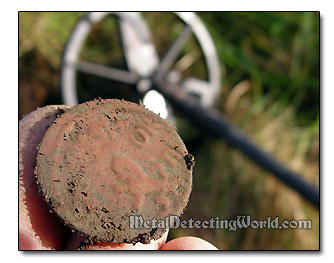
Being familiar with the Explorer's audio responses (Multi tones in Conductive sounds) to targets, I knew that I had to listen for the high-pitch tones that would correspond to the Swedish copper coins of the early 17th century.
Five minutes had not passed as I heard a desirable sound! It was not a two-way solid signal, but it was repeatable with every coil swing in one direction.
I remembered that I detected this exact spot with the Explorer the day before and did not get any signal! I started digging a hole, first recovered a rusty nail and then unearthed... a copper coin - Swedish 1666 1/6 Öre!
This was exactly the case of an iron nail lying next to the coin and partially masking it. Only the Explorer, or any other detector, could not "pick up" this masked coin. E-Trac did it! E-Trac's ability in separating the bad and good targets lying in close proximity to each other was confirmed!
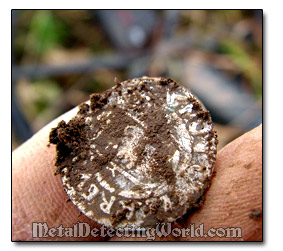
Then there was no end to my surprises for the rest of our hunt. My next find was a thin milled silver coin, ¾" in diameter. I found two of similar coins with Explorer on a previous day, but the signals given by these coins were so weak and broken that I dug them up just out of my curiosity. My buddies did not find any coins of this type with their detectors.
Again, I recovered this coin from the spot which I previously scanned with Explorer and received no signal. The E-Trac easily detected the coin and gave me a solid signal of low conductivity, the Target Crosshair stayed in one position on the screen during every coil swing, and the FE-CO read-outs barely changed.
After I recovered a few small pieces of foil and sheet copper, I was convinced that, unlike the Explorer II, E-Trac could easily detect thin and tiny non-ferrous objects. Thus, the E-Trac's high sensitivity over a wide range of targets and more accurate identification of target characteristics were also confirmed.
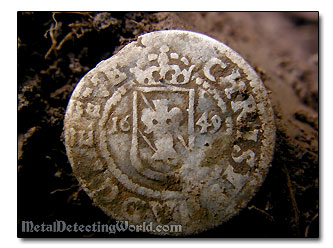
Another thing I was happy about was the E-Trac's precise and easy pinpointing of targets. This was a huge relief to me after eight years of struggling with the Explorer's terrible pinpointing!
Because of the E-Trac's excellent pinpointing, I was spending half the time that I would usually spend for target recovery with Explorer! I could not be happier!
The rest of the coin shooting hunt was a "piece of cake" for me. My coin container was getting heavy with dug coins. The process of metal detecting with E-Trac was easy and enjoyable despite the strong winds and little rain.
The E-Trac's body, even with my modifications, was well-balanced indeed - I did not feel any fatigue. The lightweight, rigid, and durable 11" Double-D search coil should also take a credit for that!
Here are the results of the first hunt (without E-Trac): Minelab Explorer II - 9 coins, White's DFX - 5 coins, Tesoro Cortes (used by a beginner who metal detected for the first time) - 2 coins.
The following are the results of the second hunt when the same spots were searched with two metal detectors: Minelab E-Trac - 11 coins, White's DFX - 3 coins.
Comparing E-Trac to the Explorer II, I can say that there is a huge difference in their performances for sure - Explorer's performance was not even close to the E-Trac's unbelievable presentation!
Even though E-Trac looks exactly like Explorer, is not an upgraded Explorer, and with a number of new features and improved electronics, E-Trac definitely represents a new generation of metal detectors!
Certainly, E-Trac takes a superior position and is undoubtedly a real breakthrough! Now I can go back to the "hunted out" sites with E-Trac and recover more "goodies" undetected by other metal detectors! The new metal detecting era, the E-Trac Era, has begun for me!
Coins I Found with Minelab Detectors - Explorer II and E-Trac, During First Two Visits to the Site
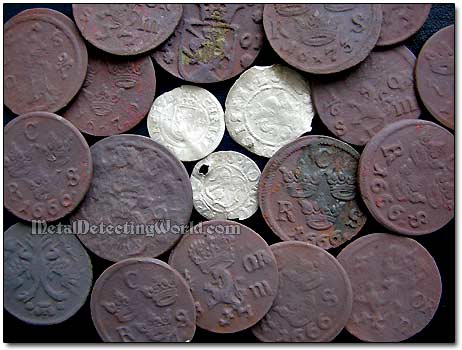
Happy Hunting!
This is an ad by Amazon. As an Amazon Associate I earn from qualifying purchases.
A Full Story can be read here: Detecting at Swedish Tavern Site, circa 17th Century
Make a Donation
Please help me stay afloat, afford more metal detecting trips with field-tests and experiments to create more informative articles, useful tutorials and helpful guides for detectorists, and maintain this website - the most informative hobby resource on the web! Since I do not have any steady income, any donation matters to me a lot! Thank you kindly!
Clicking on the donate button will take you to a donation page powered by Donorbox and dedicated to my website (MetalDetectingWorld.com). The donation page is PCI-compliant, secured by SSL/TLS, and has a simple form to fill out. Donorbox does not store any card or bank data. Credit card information is encrypted and tokenized by the Stripe payment processor.
This website would not exist without the advertisements we display and your kind donations. If you are unable to support us by viewing our advertisements, please consider making a Donation to ensure the future of this website. By helping me keep this website alive and growing, you will sure help many detectorists around the world as well!
ANNOUNCEMENT:
In January of 2020, I started a one-time fund-raising campaign in attempt to accumulate enough money to buy a simple but reliable 4x4 vehicle. My old 4x4 car (made in 1995) had faithfully served me for 10 years before it eventually went beyond repair last October. Without a 4WD, I will not be able to get to my hunt sites and test-plots hidden in the remote wooded areas inaccessible by a regular car.
Unlucky for me, those sites are the only locations available and suitable for my field-work which results in informative articles you can find on this website. For the past 10 years, my usual field-work has consisted of field-testing the latest metal detectors and accessories, experimenting with some of them, and devising new effective search methods that meet the requirements of the new metal detecting reality.
Before my car died, I managed to finish a couple of interesting detector-testing projects which will be covered in my upcoming articles. But other equally important projects that I was working on were not completed and had to be postponed until the Spring 2020. I hope that this fund-raising campaign will help me get a decent 4x4 by then so that I will be able to resume my work and to write more new articles, tutorials and guides based on data gathered through testing and experimentation.
If you find my website useful and would like it to provide more essential info for you and other detectorists worldwide, please consider chipping in $5, $20, $50 or whatever you can afford to keep MetalDetectingWorld.com growing in 2020. I promise you, it will be money well spent. Thank you.
DonateIf you would like to know how to make Minelab E-Trac semi-wireless, please visit my illustrated tutorial - "How To Make Minelab E-Trac's Operation Wireless"
- Please help me promote this article:
If you would like to follow me on Twitter, please press a button:
I have my profile page on
where you can share your thoughts on this article, ask me a question, or place a friend request.I also have my profile pages on Pinterest, LinkedIn, Tumblr, Reddit and Delicious
and my "Metal Detecting World" page on Twitter, Pinterest and Tumblr